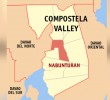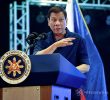I recently saw an online animation made by renowned Filipino artist Renan Ortiz entitled “Adik sa Pulbura” on the internet, showing PNP Chief Ronald “Bato” de la Rosa and Defense chief Delfin Lorenzana feverishly licking a phallic bullet until it climaxes. Racy and graphic as it is, it captures the overall fixation of the Duterte administration upon guns and arms, and the unabashed resorting to militaristic solutions to current social problems: Bato and the so-called “War on Drugs” and Lorenzana with the declaration and upholding of Martial Law.
The sanctioned use of armed force is nothing new in modern times and has been recognized by established, accepted civic entities such as the State (through the police, for example). The necessity to use armed force has always been with us; what changes are the rules by which they can be wielded, by whom, and within what contexts. The assumption is that State arms should be used to protect the citizenry, and in defense of the public good.
But lately we are faced with a dire quandary in relation to this feature of human society in the context of the war on drugs. It has lately reached a piercing clamor after the killing of Kian de los Santos, the 17-year-old student killed by police in Caloocan City during what the latter claim to be an anti-drug operation.
For many, Kian’s death stands for everything that is wrong and unjust with this government’s current use of its sanctioned arms. It should not be a far realization then that when the President says that the only solution to the drug problem is not just an armed one, but an armed one devoid of due processes, this shows a poor, irresponsible, and dangerous understanding of the place and the use of arms for the promotion of the public good.
But nevertheless, there is still a lot of support for Duterte’s war against drugs, often lauding his direct-to-the-kill approach. This raises the chilling scenario of either a bloodthirsty President and a bloodthirsty following feeding each other’s lust for carnage and vigilante justice, or of President with the aforementioned poor understanding of arms stoking the primal instincts of, and puppeteering, a blindly loyal horde he can call his own.
Related to this, though a bit more teasing out is required, is the state of the peace talks between Duterte’s government and the National Democratic Front at the moment. It can be recalled that while the peace talks have not yet formally been called off, its continuation is still far from certain. On the side of the NDFP it can be noted that its conditions for continuation have to do more about current social events, such as the release of political prisoners, an end to the regime’s fascist tendencies, follow-throughs to the President’s anti-US imperialist statements, and the lifting of Martial Law in Mindanao, among others.
On the GRP side however, if Duterte’s uninhibited pronouncements are to be believed, there is one condition and one condition only: the immediate signing of a bilateral ceasefire that will compel the New People’s Army to disarm, as well as supposedly preventing the Armed Forces from engaging the NPA.
If one thinks about it, the NDFP preconditions mentioned above are not “do-or-die” demands: the Philippine government can release political prisoners without the courts or the Department of Justice falling apart. It can lift Martial Law but still be able to battle terrorists within the lawful powers and parameters set for the State. But cancelling the armed component of revolution goes to the heart of the CPP-NDFP’s state of belligerency, something that Duterte claimed to have understood and respected when he was Davao City mayor. Which should tell us that he is completely aware of the possible repercussions of his rigid demand for a ceasefire.
Why is he doing this, then? Like his all-out war against drugs, Duterte’s insistence upon this precondition (and the tough talk that accompanies this) is an easy and clever way to maintain what he perceives to be popular support for his presidency.
What many perhaps do not yet know (maybe the President does, but I don’t know), and therefore must be made clear, is this: the NDFP is definitely not averse to signing the bilateral ceasefire and laying down arms, but there is (as in all negotiations) the crucial element of timing. The NDFP insists that the Comprehensive Agreement on Socio-Economic Reforms (or CASER) be signed first before the bilateral ceasefire. The anecdote goes that the elapsed time between the signing of the two can even be for just one second so long as it is ensured that the CASER has gone first to be mutually agreed upon, and for the implementation, by both sides.
The determination to finish and sign the CASER first shows that the national democratic movement considers this to be the more substantive issue in the peace talks aside from just simply the laying down of arms – this is what is meant by the call to address the root causes of armed conflict.
On the other hand, Duterte’s obstinacy on the bilateral ceasefire (maybe to pander to populist sentiments) is again symptomatic of how he looks at arms and armed force. His almost lewd fixation, even fetishization, of armed might makes him convinced that immediate disarmament is the sole end-all and be-all of the peace talks. He would seek to destroy the advances his regime had initially made (the most far-reaching among any of the other past presidents) just so he can crudely get his way with the quick disposal of revolutionary arms.
All this, while he continues to obscenely brandish his own against the poor, against informal settlers, the youth, the powerless, anyone with a hint of suspicion, and even those without.










